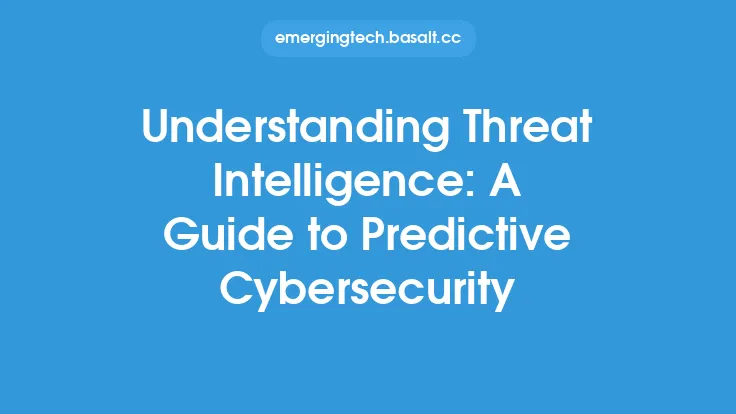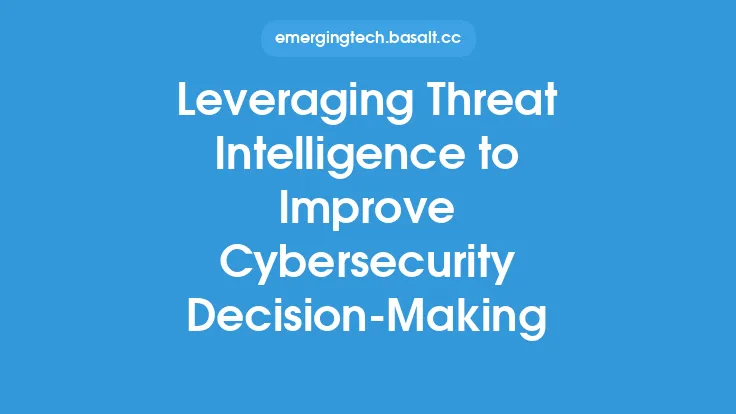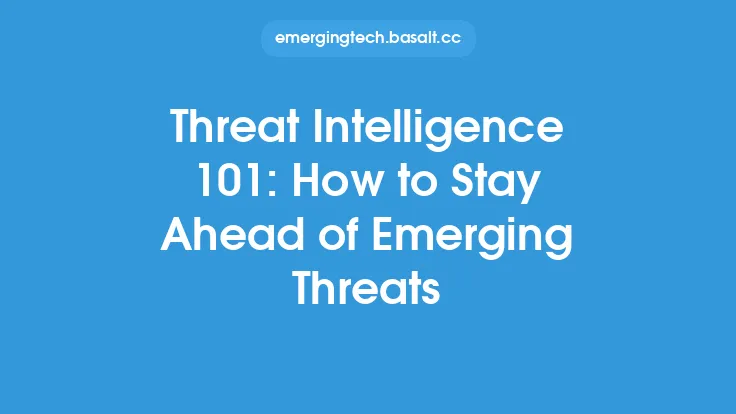Implementing threat intelligence is a crucial step in strengthening cybersecurity defenses, as it enables organizations to stay ahead of emerging threats and make informed decisions about their security posture. Threat intelligence is the process of collecting, analyzing, and disseminating information about potential or actual threats to an organization's security. This information can come from a variety of sources, including open-source intelligence, social media, and proprietary feeds.
What is Threat Intelligence?
Threat intelligence is a type of intelligence that focuses on understanding the tactics, techniques, and procedures (TTPs) used by threat actors, such as hackers, malware authors, and other cybercriminals. It involves analyzing data from various sources to identify patterns and trends that can help organizations anticipate and prepare for potential threats. Threat intelligence can be used to inform a range of security decisions, from incident response and vulnerability management to security awareness training and threat hunting.
Benefits of Implementing Threat Intelligence
Implementing threat intelligence can bring numerous benefits to an organization, including improved incident response, enhanced vulnerability management, and better security awareness. By staying informed about emerging threats and trends, organizations can take proactive steps to prevent attacks and minimize the impact of breaches. Threat intelligence can also help organizations to prioritize their security efforts, focusing on the most critical vulnerabilities and threats. Additionally, threat intelligence can provide valuable insights into the motivations and goals of threat actors, enabling organizations to develop more effective defense strategies.
Types of Threat Intelligence
There are several types of threat intelligence, each with its own unique characteristics and benefits. These include:
- Strategic threat intelligence: This type of intelligence focuses on high-level trends and patterns, providing insights into the motivations and goals of threat actors. Strategic threat intelligence is often used to inform long-term security planning and strategy.
- Tactical threat intelligence: This type of intelligence focuses on specific threats and vulnerabilities, providing detailed information about the TTPs used by threat actors. Tactical threat intelligence is often used to inform incident response and vulnerability management.
- Operational threat intelligence: This type of intelligence focuses on real-time data and analytics, providing immediate insights into emerging threats and trends. Operational threat intelligence is often used to inform security operations and threat hunting.
Implementing Threat Intelligence
Implementing threat intelligence requires a structured approach, involving several key steps. These include:
- Defining requirements: The first step in implementing threat intelligence is to define the organization's requirements and goals. This involves identifying the types of threats and vulnerabilities that need to be addressed, as well as the sources of intelligence that will be used.
- Collecting and analyzing data: The next step is to collect and analyze data from various sources, including open-source intelligence, social media, and proprietary feeds. This involves using specialized tools and techniques, such as natural language processing and machine learning, to identify patterns and trends.
- Disseminating intelligence: Once the data has been collected and analyzed, the next step is to disseminate the intelligence to relevant stakeholders. This involves creating reports, alerts, and other communications that provide actionable insights and recommendations.
- Integrating with existing security systems: Finally, the threat intelligence needs to be integrated with existing security systems, such as incident response and vulnerability management. This involves using APIs, data feeds, and other integration mechanisms to ensure that the intelligence is actionable and effective.
Technical Considerations
Implementing threat intelligence requires a range of technical considerations, including data storage, analytics, and visualization. Some of the key technical considerations include:
- Data management: Threat intelligence involves collecting and analyzing large volumes of data, which requires specialized data management systems and techniques. This includes data warehousing, data lakes, and big data analytics.
- Analytics and machine learning: Threat intelligence involves using advanced analytics and machine learning techniques to identify patterns and trends. This includes natural language processing, predictive analytics, and anomaly detection.
- Visualization and reporting: Threat intelligence involves creating reports, alerts, and other communications that provide actionable insights and recommendations. This includes data visualization, reporting, and alerting systems.
Best Practices
Implementing threat intelligence requires a range of best practices, including:
- Continuous monitoring: Threat intelligence requires continuous monitoring of emerging threats and trends. This involves using real-time data and analytics to stay informed about potential threats.
- Collaboration and information sharing: Threat intelligence involves collaboration and information sharing between organizations and stakeholders. This includes participating in threat intelligence sharing communities and using standardized formats for intelligence exchange.
- Validation and verification: Threat intelligence requires validation and verification of the intelligence to ensure that it is accurate and reliable. This involves using multiple sources and techniques to confirm the intelligence.
Common Challenges
Implementing threat intelligence can be challenging, and organizations may encounter a range of common challenges, including:
- Data overload: Threat intelligence involves collecting and analyzing large volumes of data, which can be overwhelming and difficult to manage.
- Intelligence validation: Threat intelligence requires validation and verification of the intelligence to ensure that it is accurate and reliable.
- Integration with existing security systems: Threat intelligence needs to be integrated with existing security systems, which can be complex and time-consuming.
Conclusion
Implementing threat intelligence is a crucial step in strengthening cybersecurity defenses, as it enables organizations to stay ahead of emerging threats and make informed decisions about their security posture. By understanding the benefits, types, and technical considerations of threat intelligence, organizations can develop effective threat intelligence programs that inform their security decisions and improve their overall cybersecurity posture.





